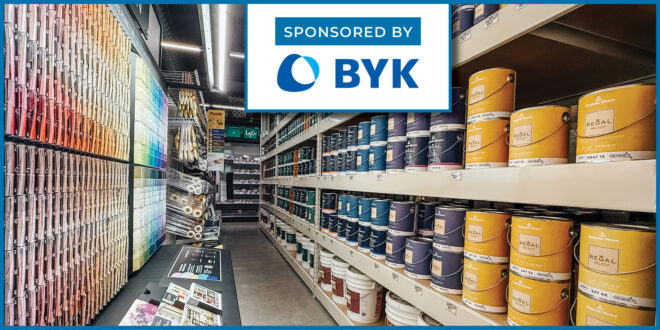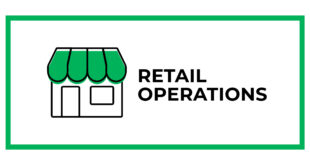By maximizing space, optimizing merchandising and fostering strong supplier relationships in the paint and sundries category, stores can better serve a diverse customer base, from DIYers to contractors. Dan’s Ace Hardware has multiple locations throughout eastern Idaho. At its location in Rexburg, Idaho, store director Ben Rowden has spent six years refining the store’s paint and sundry offerings to meet the needs of DIYers and local property managers.
Maximizing Your Space
While DIYers make up the majority of the store’s customer base, a significant number of property managers also rely on the store for paint and sundries. Many of these professionals purchase small quantities of paint regularly to keep rental properties in top condition and often need quick, reliable
access to familiar colors and brands.
“When property managers come in, they’re looking for efficiency. They know what they need and don’t have time to browse,” Rowden says. “DIYers often need more guidance, whether it’s help choosing a color or advice on the right type of paint for their project.”
When Rowden joined the store in 2019, the paint and sundries section was significantly smaller, limiting the store’s ability to meet growing demand. Sales trends made it clear that expansion was necessary, and Rowden took the steps to meet the needs for DIYers and pros.
Originally, the store had just 12 feet of space dedicated to paint and eight feet for sundries. Today, the store has expanded to offer 30 feet of paint, 16 feet of sundries and an additional 16 feet solely for paint chips—a key feature in helping customers visualize their options before making a purchase.
Having a good-better-best selection drove growth in this category was driven by the good, allowing customers to choose based on their budget and project needs.
Dan’s Ace Hardware has 10,000 square feet of floor space, and for the paint category, Rowden says he’s been able to maximize his shelf and floor space.
“I couldn’t give more space to this category if I wanted to,” he says. “We expanded our paint chip selection, which took a bit of space from other categories, but it was well worth it.”
Even with limited space, Rowden says he’s been able to create a better product selection to attract all types of customers.
“We don’t have the luxury of an unlimited footprint, so every product we carry has to serve a purpose,” he says. “We’ve curated our product selection to appeal to DIYers and contractors and have not stocked too many products.”
Strategic Merchandising and Planogram Adjustments
Before his hardware retail career, Rowden studied graphic design—an experience that has influenced his approach to merchandising.
“I’ve always been a detail-oriented person,” he says. “It’s helped me at the store because I’m able to do
trial and error to find what fits nicely on our shelves and pegboards. We follow some planograms, but we
also find what fits the best in our space.”
Rather than adhering to manufacturer planograms, Rowden adjusts layouts to improve functionality.
Paint is placed on lower shelves for easier lifting, while frequently used items like paintbrushes and rollers are positioned at eye level for better visibility. Rowden also pays close attention to product
adjacencies and stocking complementary items next to one another to encourage add-on purchases.
The adjustments Rowden made has helped streamline the shopping experience and make product selection easier for customers.
Fostering Strong Relationships
Managing a successful paint department isn’t just about selecting the right products—it’s also about ensuring that employees have the knowledge and confidence to assist customers effectively.
When Dan’s Ace Hardware switched to a new paint manufacturer, the transition was carefully planned to limit problems. Employees started with manufacturer training videos before receiving in-store training. The representative also provided ongoing product support, helping staff troubleshoot issues and refine their understanding of the products, enhancing the customer experience.
“When we make brand changes, there is always a rep who we can reach out to, and they work closely with us to support the transition,” Rowden says. “With our paint brand change, we were never left in the dark. If I need anything, I can call my rep, and they’ll train me on it or help me fix any issues. The placement and timing of the switch were all planned out to make the best possible impression on our city.”
Being the first store in Rexburg to offer this particular paint line and brand came with both opportunities and challenges. While the market had several other paint retailers, Rowden saw an opening to bring in a new option that wasn’t previously available.
“There are four or five other paint shops in town, and they all carry similar product lines,” Rowden says. “When we made the switch, we were the only ones carrying this brand for a few months.”
Later, another business 30 miles away attempted to expand into the area but was unable to sustain operations due to location challenges. Despite being in the same market, Rowden says his store helped the other store by sharing materials when needed, and sending business to them, reinforcing a cooperative rather than competitive approach.
“Not many businesses are willing to work with each other, but we believe that all of our small businesses are great businesses, and we’re all helping our community,” he says. “If I don’t have something a customer needs, I’ll send them to another store. That’s how we do things here.”
4 Keys to Meticulous Merchandising
If you’re trying to attract new shoppers to your business, you only get one chance to make a first impression, so make it a good one by having a spotless sales floor with thoughtful merchandising. Well-trained employees can help keep your store in top shape.
A great place for that training is the Basic Training in Retail Merchandising course from the North American Hardware and Paint Association. Suitable for employees at any level, the course explains how proper merchandising makes it easier for customers to shop, more likely for them to return and encourages add-on sales.
The course also discusses basic salesfloor housekeeping and maintenance. As employees take this course, here are four merchandising basics to review with them.
 Hardware Retailing The Industry's Source for Insights and Information
Hardware Retailing The Industry's Source for Insights and Information








